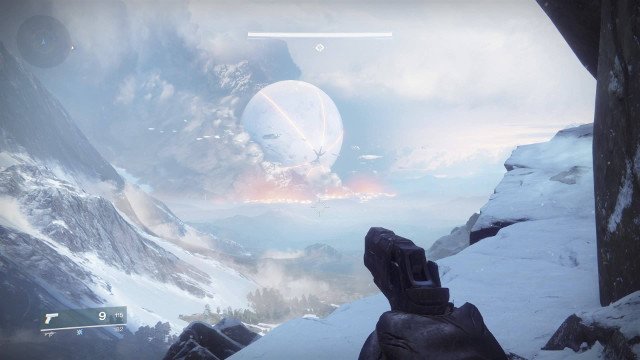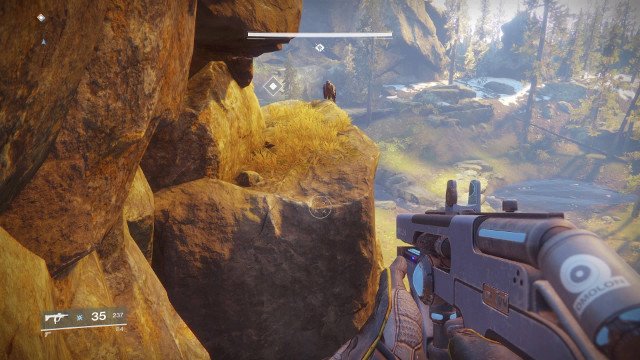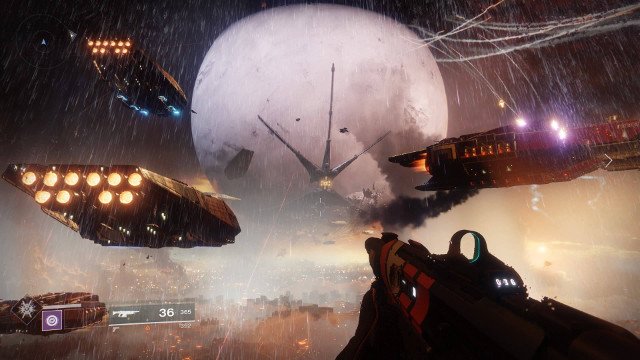We often think that the primary objective of a video game tutorial should be to hold the player’s hand through its mechanics; to introduce them to such otherworldly concepts as “press X to jump,” or “look left to turn left.” We’re inclined to believe this because of how many bad video game tutorials we’ve been forced through; for every Wheatley sarcastically chiding Chell for failing to follow basic instructions in Portal 2, or the birthday party in Fallout 3, there are innumerable others that plonk you into their world with little more than a few quick pointers, before telling you to have at it. Destiny 2 gracefully falls into the former category, with Bungie having created what will likely go down as one of the greatest tutorials ever.
Games such as Dark Souls have unfortunately undermined the artistry of the tutorial. While there’s certainly a place for games that kick you in the backside from the get-go, being deliberately obtuse about what it is you’re supposed to do and forcing you to figure things out for yourself, the increasing popularity of Souls-like games has caused many players to overlook the tutorial altogether. Now we’re told that they smother the player, offering unnecessary pointers that could easily be figured out with a little experimentation. We’re told that they’re emblematic of the problem with modern game design, in that they treat the player like a toddler unable to employ basic problem-solving skills. While this can certainly be true, there also exists tutorials like Destiny 2’s, which not only simply outline their instructions, but also roll out a red carpet in front of the player and into their world, perfectly setting the scene for the adventure that lies ahead of them.
Also: 5 Tips I Wish I Knew Before Starting Destiny 2
Destiny 2’s tutorial begins with the ferocious Cabal launching a devastating attack on the original game’s homebase, The Tower. Though I had my problems with the original Destiny, ones pervasive enough to convince me to stop playing by the time its third expansion rolled around, I still funnelled plenty of hours into it up until that point, and I’m as familiar with the layout of The Tower as any other player. I should imagine that Bungie’s wording for the Destiny 2‘s very first objective is no coincidence, then, with “defend your home” appearing on screen before your Guardian begins fighting their way through the rubble beneath the original game’s tarnished hub world. For many players, they will have spent enough time in The Tower — decoding their engrams, talking to NPCs, dancing in front of strangers — that it will feel like a home away from a home; a home that just so happens to have a giant, magical sphere of untold power floating behind it.

For a while, Destiny 2‘s tutorial confines itself to corridors in which you’re guided through the basics. Press this button to jump, this one to crouch, this one to do a neat booster jump, and so on. But as it continues, the game begins to show its hand a little more. First, you’re led out into a spacecraft hangar where enemies try to flank you, forcing you to think on your toes — you hide behind cover to recharge your health, and have the opportunity to use the platforms overhanging it for extra verticality using the aforementioned booster jump. Then, you make your way to The Tower as Destiny‘s players know it; the large square looking out onto the looming presence of The Traveler, once permanently bathed in sunlight, but now shrouded in foreboding darkness with Cabal ships thrusting menacingly towards it.
The Tower looks the same, but different all at once; the immaculate stonework beneath your feet is blown to pieces, while the stations of the vendors you gave all your Glimmer to are torn apart. Cabal jump in from above you, attacking relentlessly while you try to hold them back. You notice that your fellow Guardians, actual players, are rushing in next to you in an effort to help. The tutorial is single-player, but again, this is Bungie showing you what you should expect; you will fight off the Cabal while standing side-by-side with strangers, and you will co-operate with them and revive them when necessary. It all fits in so effortlessly with the story Bungie is telling that you don’t even notice what the game has done: it’s introduced you to its persistent world, and how you’ll interact with the players inside it.
As the original Destiny progressed with its Raids, it began to incorporate objectives other than “run to this place, shoot this enemy.” Platforming and puzzles became a part of the experience, too, and the tutorial lets the player dip their toes in these waters. During one segment, it’s required that the player must destroy three exhaust turbines, with a large, electric, spinning mechanism blocking two of them. Touching the mechanism results in insta-death, meaning the player must walk ahead of them, quickly dropping down onto a secure platform before destroying each turbine. It’s a simple objective, but again, it’s one that most players wouldn’t even notice had taught them a key component of the game.

Similarly, after the player’s Guardian is left half-dead by main antagonist Ghaul and forced to fight against nature without their Light, they’re once again tasked with managing platforms in between intervals of fending off enemies, under the guise of “following a falcon” to their destination. This concludes with your Guardian being confronted with one hard-to-reach ledge and, if you’re like me, no small amount of deliberating in regards to how to cross it. With my boost jump being taken and my sprint nullified, I assumed there must have been a different way to make my way to this ledge, but nope; in another memorable moment from an opening chapter full of them, you’re always doomed to fall to the ground below, before being rescued and carried off to Destiny 2’s ramshackle new hub world, The Farm.
I haven’t progressed far enough into Destiny 2 to personally judge whether or not the rest of the game manages to live up to its opening 45 minutes. However, in this tutorial I felt more engaged, more engrossed in the story that Bungie was trying to tell, than in any part of the original Destiny‘s base game. With this opening act, Bungie masterfully frames Destiny 2’s story, smothers it in fan service while simultaneously introducing newcomers to its basics, but it’s such a perfect balancing act that it all plays out like a mission in its own right, and an exhilarating taster of what’s to come. This is how you introduce a game.










